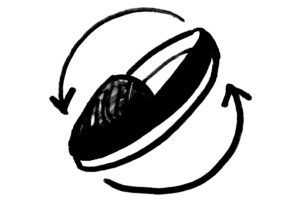- Author of the text: Vlasta Pechova, 10. 4. 2022, Prague, Czech Republic (přečtěte si českou verzi)
 „Rotating Shoe As a Gateway To Universe“
„Rotating Shoe As a Gateway To Universe“
The classical texts of the masters say: „Although the changes are numerous, the principle that pervades them is only one.“ You know this principle, which the old masters had in mind. It is graphically displayed as a monad. It’s like a black and white circular pattern.
So many times have I read about the monad, what it expresses, how it all works. Something was understandable. On the contrary, something confused me and I often put the books away with the feeling that I was lost in the whole thing. The most logical explanation, which was immediately clear to me and I found it really fascinating, was given to me by my teacher Bob (Robert Amacker – Yang style Taijiquan).
He explained it quite simply. He took off his shoe, laid it on the ground, and kicked it from one side. The shoe was made of fabric and so it spun on the slippery floor. Suddenly it was clear as a slap. What is usually done with so much hype has been presented to me so banally! That elusive touch, very close, materialized in the rotation of an ordinary shoe.
 This is how simply Bob introduced a point of retreat. The shoe retreated where he had kicked it. The complementary point – point of advance – was on the other side of the shoe. And there was also a center around which the shoe revolved. The points of retreat and advance are the interplay of opposites, their constant transformation. Other examples are day and night, fullness and emptiness, warmth and cold etc.
This is how simply Bob introduced a point of retreat. The shoe retreated where he had kicked it. The complementary point – point of advance – was on the other side of the shoe. And there was also a center around which the shoe revolved. The points of retreat and advance are the interplay of opposites, their constant transformation. Other examples are day and night, fullness and emptiness, warmth and cold etc.
To understand Taijiquan (Tai chi) exercises, an image of a rotating shoe or other object is enough. In our school, we call this pervasive principle the Taiji Principle. We learn to work with it in physical movement. We don’t need much more of it’s philosophical explanation. We are permeated by this principle as we constantly strive to find and create it in Taijiquan practice. As a gift for that effort, we receive the fact that this principle – through movement – reaches our subconscious, our actions and the perception of the world.
And do you know what seemed the hardest to me about this principle? Once you master the point of retreat where your sparring partner is pushing you and you are retreating at that point, you still need to find the second, complementary point. And that seems a lot harder than the retreat. Probably because Taiji is said to be about yielding… Yes it is. But beware, there is another point that can surprise you a lot.
